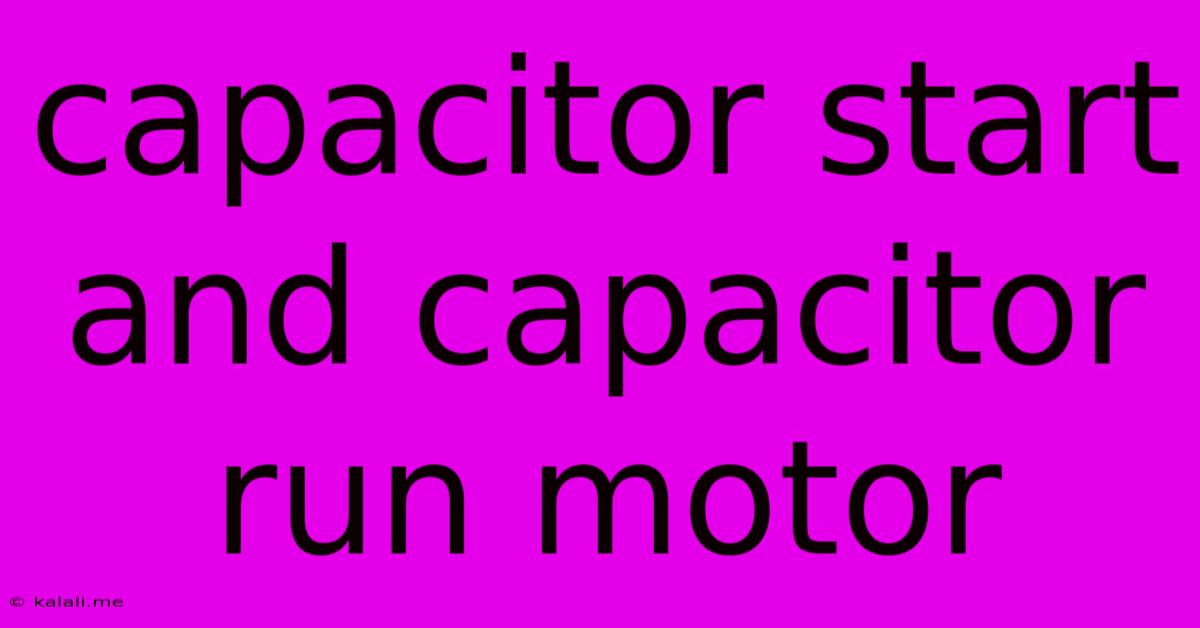Capacitor Start And Capacitor Run Motor
Kalali
Jun 12, 2025 · 3 min read

Table of Contents
Capacitor Start and Capacitor Run Motors: A Comprehensive Guide
Meta Description: Understand the differences between capacitor start and capacitor run motors. This guide explains their operation, applications, advantages, and disadvantages, helping you choose the right motor for your needs. Learn about single-phase motor types and their applications in various industries.
Capacitor start and capacitor run motors are types of single-phase induction motors widely used in various applications due to their high starting torque and relatively simple design. While both utilize capacitors to improve performance, they differ significantly in their operation and characteristics. This article will delve into the specifics of each type, highlighting their advantages, disadvantages, and typical applications.
Capacitor Start Motors: High Starting Torque, Simple Design
Capacitor start motors use a capacitor in the starting circuit to create a phase shift, allowing the motor to develop sufficient torque to start its load. This capacitor is only engaged during the starting phase. Once the motor reaches a predetermined speed, typically around 75% of its rated speed, a centrifugal switch disconnects the capacitor from the circuit.
How it Works:
- A capacitor is connected in series with an auxiliary winding.
- This creates a phase difference between the main and auxiliary windings, producing a rotating magnetic field.
- This rotating field induces current in the rotor, causing it to start rotating.
- Once the motor reaches a certain speed, the centrifugal switch disconnects the capacitor.
Advantages:
- High starting torque: Excellent for applications requiring high initial torque to overcome inertia.
- Simple and inexpensive: Relatively simple design, resulting in lower manufacturing costs.
- Easy to maintain: Fewer components to potentially fail compared to other motor types.
Disadvantages:
- Lower running torque: The running torque is generally lower compared to capacitor-run motors.
- Potential for wear and tear on centrifugal switch: The centrifugal switch is a mechanical component prone to failure over time.
- Not suitable for continuous high-load applications: The reduced running torque limits their use in applications demanding consistent high power.
Typical Applications:
Compressors, pumps, fans, and other applications requiring high starting torque but not necessarily high running torque.
Capacitor Run Motors: Consistent Performance, Enhanced Efficiency
Capacitor run motors employ a capacitor permanently connected in series with the auxiliary winding. This ensures a continuous phase shift, providing improved running torque and efficiency compared to capacitor start motors.
How it Works:
- A capacitor is permanently connected in series with the auxiliary winding.
- This creates a continuous phase difference, resulting in a stronger and more consistent rotating magnetic field.
- This leads to higher running torque and improved efficiency compared to capacitor start motors.
Advantages:
- High running torque: Provides consistent torque throughout the motor's operating range.
- Improved efficiency: The continuous phase shift enhances motor efficiency.
- Quieter operation: Generally quieter than capacitor start motors due to smoother operation.
Disadvantages:
- Lower starting torque: Compared to capacitor start motors, the starting torque is lower.
- Higher cost: The permanent capacitor and associated wiring add to the overall cost.
- Higher capacitor voltage rating required: The capacitor needs to handle continuous operation.
Typical Applications:
Fans, blowers, small pumps, and other applications requiring high running torque and smooth operation.
Capacitor Start and Capacitor Run Motor Comparison Table:
| Feature | Capacitor Start Motor | Capacitor Run Motor |
|---|---|---|
| Starting Torque | High | Lower |
| Running Torque | Lower | High |
| Efficiency | Lower | Higher |
| Cost | Lower | Higher |
| Noise Level | Higher | Lower |
| Capacitor | Temporary | Permanent |
| Applications | High-torque starting | Smooth operation |
Choosing the Right Motor:
Selecting between a capacitor start and capacitor run motor depends heavily on the specific application. If high starting torque is paramount, a capacitor start motor might be the better choice. However, if consistent running torque, higher efficiency, and quieter operation are more critical, a capacitor run motor is generally preferred. Consider the load characteristics, required starting torque, and the overall operational requirements before making a decision. Consulting with a motor specialist can help ensure you select the most suitable motor for your specific needs.
Latest Posts
Latest Posts
-
Motors With Two Separate Winding Circuits Employ
Jun 13, 2025
-
How To Find Directrix Of Ellipse
Jun 13, 2025
-
What Is The Least Common Multiple Of 6 And 11
Jun 13, 2025
-
How Many Legs Does Ants Have
Jun 13, 2025
-
Average Gpa For University Of Vermont
Jun 13, 2025
Related Post
Thank you for visiting our website which covers about Capacitor Start And Capacitor Run Motor . We hope the information provided has been useful to you. Feel free to contact us if you have any questions or need further assistance. See you next time and don't miss to bookmark.